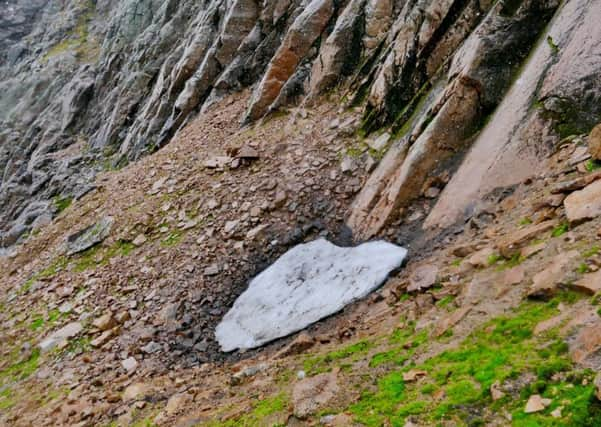Scotland's longest lying patch of snow set to disappear


The build up of snow, known as the Sphinx, has been present on the Cairngorms for more than a decade, and according to scientists has disappeared only five times in the past three centuries.
However, the patch – at Garbh Choire Mòr on Braeriach in the Cairngorms – has rapidly shrunk this year, and measures little more than four metres wide.
Advertisement
Hide AdAdvertisement
Hide AdIain Cameron, a snow researcher who has been monitoring Scotland’s slopes for the past two decades, said he expected the patch to disappear altogether over the next few days.
Although the most recent winter was Scotland’s third warmest since 1910, Mr Cameron said there were other factors behind the lack of snow.
He explained: “The main reason is not the warmth, but the amount of precipitation that fell over winter. It was an extraordinarily dry winter and not much snow fell at all – the Scottish ski centres all reported very poor skier day numbers and it’s no coincidence that the patches of snow are correspondingly smaller.”
If, as Mr Cameron predicts, the Sphinx vanishes over the next few days, it will be one of only a handful of times it has disappeared.
The snow patch, named after the challenging rock climb directly above it, has been a reliable fixture observed by generations of mountaineers and naturalists. When it vanished in 1933, the Scottish Mountaineering Club felt compelled to write a letter to the Times newspaper, pointing out that such a thing “had never been known before”.
According to records, the snow disappeared only two more times over the following six decades, with total melts in 1953 and 1959.
However, the trend has intensified in recent years, with the patch melting away in 1996, 2003, and 2006.
On any given year, Mr Cameron, from Stirling, said there would be between 50 to 100 patches left by the middle of September, but the Sphinx is one of only two patches remaining in Scotland in 2017, with the other – located on Aonach Beag – also expected to melt away over the next few days.
Advertisement
Hide AdAdvertisement
Hide AdMr Cameron, environmental manager for an aerospace company, has been collating data on snow patches for years, and his research – which he describes as an amateur labour of love – has been published by the Royal Meteorological Society since 2005,